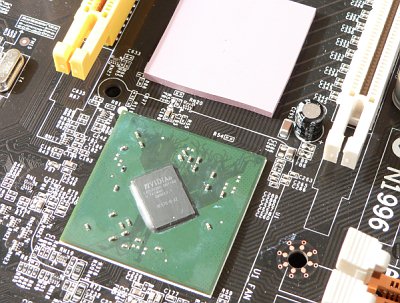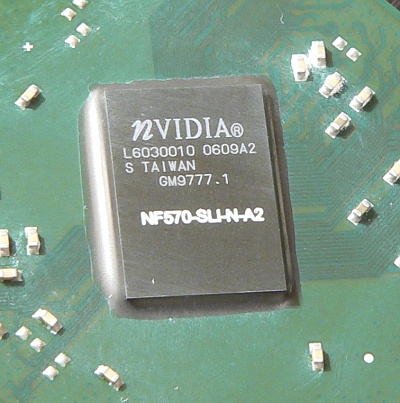MSI K9N Platinum and MSI K9N SLI Platinum — Motherboards on NVIDIA nForce 570 Ultra/SLI Chipset
|
Since we had enough time to look at peculiarities of AMD's new platform, let's not delay and proceed to the first Socket AM2 motherboards in our lab kindly provided by MSI. This is a couple of similar boards (the differences are described below) occupying high positions in MSI's product series. A usual feature of such boards is rich functionality and thorough packages without any fanciful expensive toys.
MSI K9N Platinum
- Chipset: NVIDIA nForce 570 Ultra (a unified MCP55Ultra bridge)

Besides DDR2 memory slots, the new platform is given away by a modified socket frame. The frame is fixed to the motherboard in four instead of two points. But rumors about the incompatibility with Socket 939 coolers are exaggerated. Indeed, the retention system of the new boxed coolers has been modified (four holes at the edge of the frame), but traditional projections are preserved as well for compatibility. For the only difference that Socket 939 has three of them at each side of the socket, and now only the central one is left. Thus, only coolers with the original retention system may be left out of it - their installation required removing the standard frame and securing the assembly right through the mounting holes in a motherboard.

Look at the passive cooling of the chipset - such a solution was exotic for nForce4, but it promises to become typical for the 500th series. MSI engineers use a long low-profile heatsink. It's not installed on the center of the chip. It overhangs a motherboard at one side, tied to it through an insulating pad. The heatsink gets very hot. But active cooling is not necessary, because this chip can operate at up to 90°C and its own heat release is reduced. The motherboard was stable at the standard frequencies. But if you plan on testing this system in an overclocked mode, you will still need additional cooling. Note that enthusiast series (MSI Diamond, in particular) will be still bundled with robust cooling systems for this chipset.
Even though the motherboard is based on the chipset, which officially does not support SLI, it still has two PCI Express x16 ports. The second port (yellow), always operating in PCI Express x1 mode, can be used for the second video card - for another pair of monitors. Considering that the PCB layout is identical to the model on nForce 570 SLI, we cannot rule out a possibility of unlocking additional PCI Express lanes and SLI mode, which will probably be available in the Ultra version of the chipset.
The board is equipped with a 4-pin ATX12V connector. Besides, video cards in PCI Express x16 slots can be powered from the standard 4-pin peripheral connector. The 3-phase switching voltage regulator of the processor incorporates 3 field-effect transistors per channel, six 3300 uF capacitors and four 1500 uF ones. All capacitors are always from one manufacturer, but not from the first echelon (unknown brand). Memory voltage regulator uses capacitors from Rubycon and is reinforced with L elements. There are no empty seats on this motherboard — Platinum series from MSI traditionally differs from "simple" models by a full set of additional controllers, provided by the board design. It's inferior to the Diamond series only in its bundle and "safety margin" of the cooling system. Motherboard dimensions — 305x245 mm (full-size ATX), nine-screw mount, all corners are firmly fixed.
System monitoring (Winbond W83627EHG, according to BIOS Setup)
- CPU voltage, +3.3, +5, +12 V
- Rotational speed of one fan
- CPU and board temperatures (by the corresponding embedded sensors)
- SmartFan — automatic CPU fan speed control depending on CPU temperature. You can select two modes of the CPU fan, to control its rotational speed:
- Thermal Cruise — gradual change (8 steps — each one is 8% faster) of the rotational speed, temperature is automatically maintained within the specified thermal interval
- Step Smart Fan — you are offered to specify two temperature thresholds. In this case, when the temperature is below the minimal threshold, the rotational speed is kept to minimum. When the temperature is within the specified range, the rotational speed is raised stepwise. When the upper threshold is crossed, the fan accelerates to its maximum speed.
Onboard ports, sockets, and connectors
- Processor socket (Socket AM2, officially supports all existing processors AMD Athlon 64/X2/FX and Sempron);
- 4 x DDR2 SDRAM DIMM (up to 8 GB DDR2-533/667/800, dual-channel mode)
- 2 x PCIEx16 for video accelerators (always work in x16+x1 mode)
- 2 x PCIEx1
- 3 x PCI (the orange slot has a separate power circuit, it's intended for MSI Dual Net Card, but it can also be used as a regular PCI slot)
- Power connectors: standard ATX 2.2 (24 pins), 4-pin ATX12V for a processor, 4-pin peripheral connector for additional power supply of PCI-E video cards
- 1 x FDD
- 1 x IDE (Parallel ATA) for two ATA133 devices - chipset-based
- 6 x SATA-II (Serial ATA II) for six SATA300 devices — chipset-based, connected drives can form RAID 0, 1, 0+1, 5
- 3 connectors for brackets with 6 additional USB ports
- Connector for the bracket with an additional FireWire port
- Connector for the 4-LED indicator on the D-Bracket
- 1 x CD/DVD audio connector
- Connectors for analog audio ins and outs on the front panel
- Connector for a chassis intrusion sensor
- 1 x standard IrDA connector
- 3 x fan headers, only one of them allows rpm control (in the current BIOS version). Smart Fan mode is available only with a 4-pin cooler.
Back panel (left to right, blockwise)

Click the image to open the rear view of this motherboard
- PS/2 mouse and keyboard
- 1 x LPT, 1 x COM, 1 x FireWire, 1 x coaxial S/PDIF-Out
- 2 x USB and 1 x RJ-45 (Gigabit Ethernet)
- 2 x USB and 1 x RJ-45 (Gigabit Ethernet)
- 5 x Analog Audio (Line-In, Line-Out, Mic-In, Rear Speaker Out, Center/Sub Speaker Out), 1 x Optical (Toslink) S/PDIF-Out.
Integrated Controllers
- Audio, based on the chipset support for High Definition Audio and Realtek ALC833 codec, 7.1 channel audio, front line-ins/outs, CD-In, and S/PDIF-Out jacks
- 2 x Gigabit Ethernet supporting 10/100/1000 Mbit/s: chipset-based (supporting high-speed interface and hardware firewall) and PHY Vitesse VSC8601
- FireWire, based on the VIA VT6307 chip supporting two FireWire ports.
Note the support for two gigabit network adapters, integrated into the new chipset.
Settings
| Jumpers and switches | Clear CMOS button(!) | |
| In BIOS v2.59 from AMI | Allows to disable specific CPU functions | + | K8 Cool’n’Quiet |
| Memory timings | + | 1T/2T Memory Timing, CAS Latency, Min RAS Active Time, Row Precharge Time, RAS to CAS Delay, Row to Row Delay, Row Cycle Time |
| Memory frequency selection | + | 500, 533, 667, 800 (you actually specify a multiplier to the HTT frequency) |
| HT bus setup |
+ | Frequency (200, 400, 600, 800, 1000) for the northbridge-CPU bus and capacity (8 bit or 16 bit) |
| Peripheral bus frequency control | + |
PCI-E = 100—145 MHz at 1 MHz steps |
| PCI IRQ manual assignment | + | |
| FSB frequency setup | + |
200—450 MHz at 1 MHz steps and Dynamic Overclocking (1–15% overclocking under maximum load) |
| CPU multiplier | + | from x5, at integer steps |
| CPU core voltage control | + | +0.05—0.35V at 0.05V steps |
| Memory voltage control | + | 1.80—2.45 V at 0.05V steps |
We used BIOS 9.03 dated 20.04.06, the latest available BIOS version at the time of our tests. The mentioned BIOS parameters are available in this version, but the viability of non-standard settings hasn't been tested.
MSI K9N SLI Platinum
- Chipset: NVIDIA nForce 570 SLI (a unified MCP55SLI bridge)

As the top model is identical to the previous one (including the same BIOS version), except for the installed chip of the core logic and SLI support (x8 + x8), there is no need to list its features separately.
Note that the motherboard has no jumpers to select video slot modes, they are switched on the chipset level.

The core logic chip on the first production motherboards has an official designation already.
Performance
The performance issues are described in our general article about the new socket. For more details on Socket 939 and Socket AM2 comparison, please see another article that also reviews the new top-end AMD Athlon 64 FX-62 processor.
Bottom line
At the moment we have nothing to compare these motherboards with, and they are almost identical to each other (with an exception of SLI support). Still, considering the previous experience, we can say that both K9N Platinum boards are interesting products. Though a bit expensive, they are solidly packed with cabling, brackets and manuals as well as additional and chipset controllers and ports. We do not see any sense in rushing towards AMD's new platform. But if you had such plans, then you have at least two motherboards that can help build a good system with Socket AM2.
MSI K9N Platinum official page
MSI K9N SLI Platinum official page
Motherboards were kindly provided by MSI
Dmitry Vladimirovich (lpt@ixbt.com)
May 23, 2006
Write a comment below. No registration needed!
|
|
 |
|
|
|





